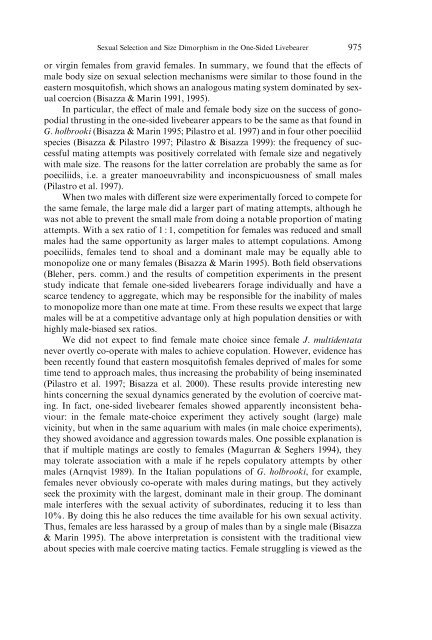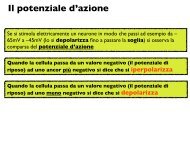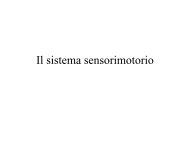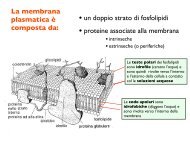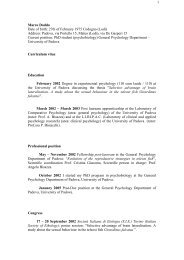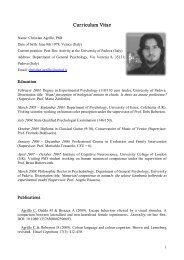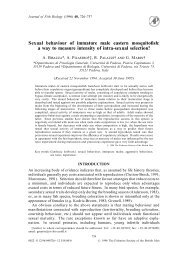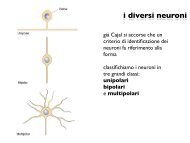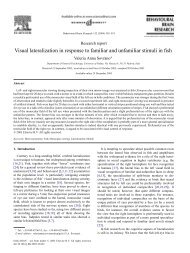Sexual Competition, Coercive Mating and Mate Assessment ... - CPRG
Sexual Competition, Coercive Mating and Mate Assessment ... - CPRG
Sexual Competition, Coercive Mating and Mate Assessment ... - CPRG
Create successful ePaper yourself
Turn your PDF publications into a flip-book with our unique Google optimized e-Paper software.
<strong>Sexual</strong> Selection <strong>and</strong> Size Dimorphism in the One-Sided Livebearer975or virgin females from gravid females. In summary, we found that the e€ects ofmale body size on sexual selection mechanisms were similar to those found in theeastern mosquito®sh, which shows an analogous mating system dominated by sexualcoercion (Bisazza & Marin 1991, 1995).In particular, the e€ect of male <strong>and</strong> female body size on the success of gonopodialthrusting in the one-sided livebearer appears to be the same as that found inG. holbrooki (Bisazza & Marin 1995; Pilastro et al. 1997) <strong>and</strong> in four other poeciliidspecies (Bisazza & Pilastro 1997; Pilastro & Bisazza 1999): the frequency of successfulmating attempts was positively correlated with female size <strong>and</strong> negativelywith male size. The reasons for the latter correlation are probably the same as forpoeciliids, i.e. a greater manoeuvrability <strong>and</strong> inconspicuousness of small males(Pilastro et al. 1997).When two males with di€erent size were experimentally forced to compete forthe same female, the large male did a larger part of mating attempts, although hewas not able to prevent the small male from doing a notable proportion of matingattempts. With a sex ratio of 1 : 1, competition for females was reduced <strong>and</strong> smallmales had the same opportunity as larger males to attempt copulations. Amongpoeciliids, females tend to shoal <strong>and</strong> a dominant male may be equally able tomonopolize one or many females (Bisazza & Marin 1995). Both ®eld observations(Bleher, pers. comm.) <strong>and</strong> the results of competition experiments in the presentstudy indicate that female one-sided livebearers forage individually <strong>and</strong> have ascarce tendency to aggregate, which may be responsible for the inability of malesto monopolize more than one mate at time. From these results we expect that largemales will be at a competitive advantage only at high population densities or withhighly male-biased sex ratios.We did not expect to ®nd female mate choice since female J. multidentatanever overtly co-operate with males to achieve copulation. However, evidence hasbeen recently found that eastern mosquito®sh females deprived of males for sometime tend to approach males, thus increasing the probability of being inseminated(Pilastro et al. 1997; Bisazza et al. 2000). These results provide interesting newhints concerning the sexual dynamics generated by the evolution of coercive mating.In fact, one-sided livebearer females showed apparently inconsistent behaviour:in the female mate-choice experiment they actively sought (large) malevicinity, but when in the same aquarium with males (in male choice experiments),they showed avoidance <strong>and</strong> aggression towards males. One possible explanation isthat if multiple matings are costly to females (Magurran & Seghers 1994), theymay tolerate association with a male if he repels copulatory attempts by othermales (Arnqvist 1989). In the Italian populations of G. holbrooki, for example,females never obviously co-operate with males during matings, but they activelyseek the proximity with the largest, dominant male in their group. The dominantmale interferes with the sexual activity of subordinates, reducing it to less than10%. By doing this he also reduces the time available for his own sexual activity.Thus, females are less harassed by a group of males than by a single male (Bisazza& Marin 1995). The above interpretation is consistent with the traditional viewabout species with male coercive mating tactics. Female struggling is viewed as the


